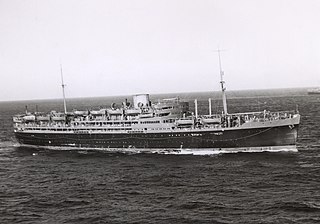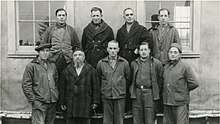4 Canadian Division Support Base Petawawa, commonly referred to as Garrison Petawawa, is located in Petawawa, Ontario. It is operated as an army base by the Canadian Army.

From 1942 to 1949, Canada forcibly relocated and incarcerated over 22,000 Japanese Canadians—comprising over 90% of the total Japanese Canadian population—from British Columbia in the name of "national security". The majority were Canadian citizens by birth and were targeted based on their ancestry. This decision followed the events of the Japanese Empire's war in the Pacific against the Western Allies, such as the invasion of Hong Kong, the attack on Pearl Harbor in Hawaii, and the Fall of Singapore which led to the Canadian declaration of war on Japan during World War II. Similar to the actions taken against Japanese Americans in neighbouring United States, this forced relocation subjected many Japanese Canadians to government-enforced curfews and interrogations, job and property losses, and forced repatriation to Japan.

Italian Canadians or Italo-Canadians are Canadian-born citizens who are fully or partially of Italian descent, whose ancestors were Italians who migrated to Canada as part of Italian diaspora, or Italian-born people in Canada. According to the 2021 Census of Canada, 1,546,390 Canadians claimed full or partial Italian ancestry. They comprise a subgroup of Southern European Canadians which is a further subgroup of European Canadians. The census enumerates the entire Canadian population, which consists of Canadian citizens, landed immigrants and non-permanent residents and their families living with them in Canada. Residing mainly in central urban industrial metropolitan areas, Italian Canadians are the seventh largest self-identified ethnic group in Canada behind French, English, Irish, Scottish, German and Chinese Canadians.

Tatura is a town in the Goulburn Valley region of Victoria, Australia, and is situated within the City of Greater Shepparton local government area, 167 kilometres (104 mi) north of the state capital (Melbourne) and 18 kilometres (11 mi) west of the regional centre of Shepparton. At the 2021 census, Tatura had a population of 4,955.

The Ukrainian Canadian internment was part of the confinement of "enemy aliens" in Canada during and for two years after the end of the First World War. It lasted from 1914 to 1920, under the terms of the War Measures Act.
In customary international law, an enemy alien is any alien native, citizen, denizen or subject of any foreign nation or government with which a domestic nation or government is in conflict and who is liable to be apprehended, restrained, secured and removed. Usually, the countries are in a state of declared war.

German Australians are Australians with German ancestry. German Australians constitute one of the largest ancestry groups in Australia, and German is the fifth most identified European ancestry in Australia behind English, Irish, Scottish and Italian. German Australians are one of the largest groups within the global German diaspora.
The internment of Italian Americans refers to the US government's internment of Italian nationals during World War II. As was customary after Italy and the US were at war, they were classified as "enemy aliens" and some were detained by the Department of Justice under the Alien and Sedition Act. But in practice, the US applied detention only to Italian nationals, not to US citizens, or long-term US residents. Italian immigrants had been allowed to gain citizenship through the naturalization process during the years before the war, and by 1940 there were millions of US citizens who had been born in Italy.

HMTDunera was a British passenger ship which, in 1940, became involved in a controversial transportation of thousands of "enemy aliens" to Australia. The British India Steam Navigation Company had operated a previous Dunera (1891), which served as a troopship during the Second Boer War.

Fort Missoula Internment Camp was an internment camp operated by the United States Department of Justice during World War II. Japanese Americans and Italian Americans were imprisoned here during this war.

Internment of German resident aliens and German-American citizens occurred in the United States during the periods of World War I and World War II. During World War II, the legal basis for this detention was under Presidential Proclamation 2526, made by President Franklin Delano Roosevelt under the authority of the Alien Enemies Act.

Collar the Lot! How Britain Interned & Expelled its Wartime Refugees is a book by Peter Gillman and Leni Gillman. It is a detailed account of British internment policy during the Second World War.

Crystal City Internment Camp, located near Crystal City, Texas, was a place of confinement for people of Japanese, German, and Italian descent during World War II, and has been variously described as a detention facility or a concentration camp. The camp, which was originally designed to hold 3,500 people, opened in December 1943 and was officially closed on February 11, 1948.

Canada and Italy. Both nations enjoy friendly relations and are close allies and partners through their membership in the G7, G20, NATO and the Organisation for Economic Co-operation and Development. Relations also centre on the history of Italian migration to Canada; approximately 1.5 million Canadians claim to have Italian ancestry.

Eaton Internment Camp, although short-lived, was one of twenty-four official internment facilities created in Canada to accommodate prisoners of war during the period from 1914 to 1920. It was the only facility of its kind in the province of Saskatchewan.

The Castle Mountain Internment Camp, located in Banff National Park, Alberta, was the largest internment facility in the Canadian Rockies, housing several hundred prisoners at any one time. Established on July 13, 1915, a total of 660 enemy aliens were interned at the facility during its entire operation.

The Hay Internment and POW camps at Hay, New South Wales, Australia were established during World War II as prisoner-of-war and internment centres, due in part to the isolated location of the town. Three high-security camps were constructed in 1940. The first arrivals were 2,542 internees from Nazi Germany and Austria, most of whom were Jewish; they had been interned in the United Kingdom as enemy aliens when the possibility of an Axis invasion of Britain was at its highest.
Italian prisoners of war in Australia were Italian soldiers captured by the British and Allied Forces in World War II and taken to Australia.

The history of the Jews in the Isle of Man goes back to at least the early 19th century.















